Everyone loves a juicy tomato fresh off the vine, but dozens of tomato pests can limit the number of tomatoes you can get off a single plant.
Read through this article to learn more about some of the most common tomato pests you may find on your tomato plants.
Stink Bugs

If you aren’t someone who has had the displeasure of smelling a stink bug that cracked open, you should consider yourself lucky!
The smell of a stink bug is something that I can’t describe, but the smell isn’t the only problem. Stink bugs can ruin your tomatoes too!
Stink bugs won’t ruin the leaves on your plant, but stink bugs can quickly destroy your tomatoes before they have a chance to grow.
Stink bugs will eat through young tomatoes and ruin them before they can grow any bigger.
Few things will get rid of stink bugs other than picking them up, so prevention is the best method for these smelly bugs. Don’t put your tomatoes in shaded areas if they are in pots, and don’t give stink bugs places to hide in debris in early spring.
Aphids
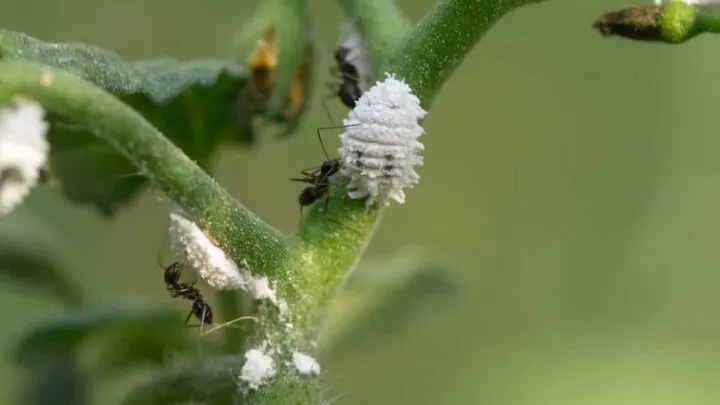
Aphids are one of the most common pests you’ll find on tomato plants, targeting the sap in the tomato leaves.
Aphids can cause nasty diseases that will kill the foliage on your tomato plant and can even harm the tomatoes themselves if the infestation is severe enough.
Even though aphids can destroy your tomato plants, aphids are also easy to get rid of.
Although annoying and time-consuming, you can pick off aphids by hand. You can also purchase aphid spray or make your own at home if you prefer not to touch the aphids on your tomato plants.
Cutworms
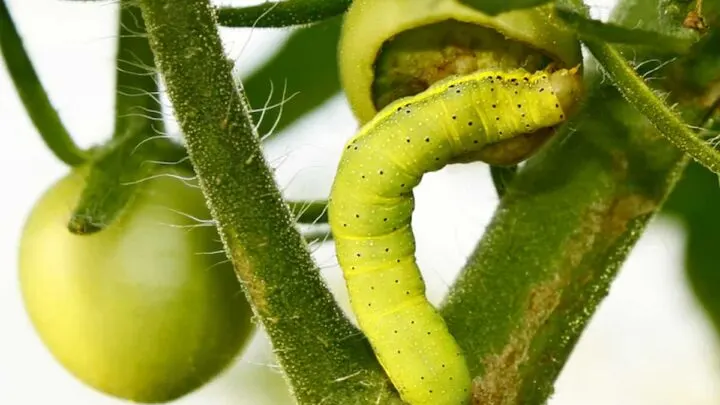
Worm is in the name, but cutworms are a type of caterpillar, believe it or not.
Cutworms can be devastating to your tomato plants because these pests target the stem of your tomato plant. The pests can chew on the stem or even cut through it (see where the name comes from?), causing your tomato plant to fall.
You can avoid using chemicals to eliminate cutworms if you have a small garden at home. Cutworm infestations usually aren’t that severe.
Like with stink bugs, prevention is better than using chemicals. Keep your tomato plants free from weeds and debris, and you won’t need to worry about cutworms as much as you might think.
Potato Beetles
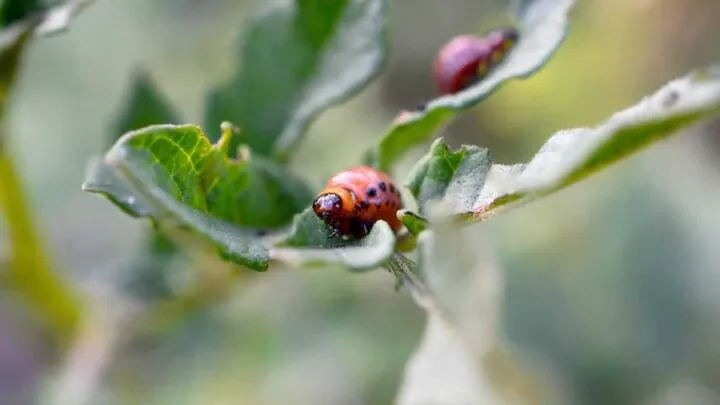
Potatoes aren’t the only thing that potato beetles eat; they’ll target your tomato plants too.
Potato beetles will target the flowers on your tomato plants before your tomatoes start to grow so that these little pests can ruin your entire crop.
As the name suggests, you might also find potato beetles on your potatoes, eggplants, and even peppers.
Thrips
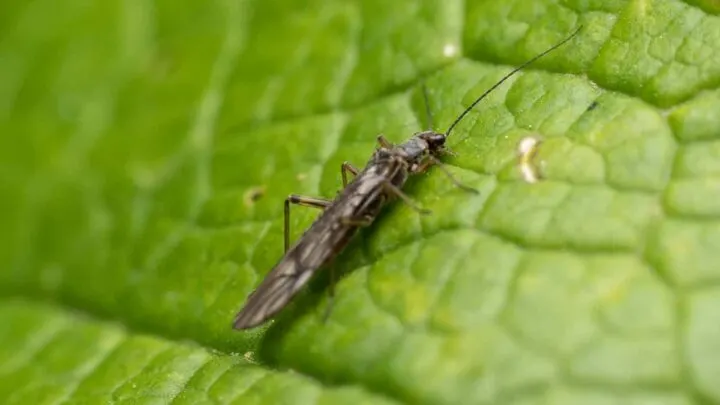
No, I didn’t mean to say “trip”! Thrips are a type of pest that eats tomato plants before they have a chance to grow larger than seedlings.
Thrips are one of the most dangerous species of pest because they target seedlings before they have a chance to grow. If thrips spread through your garden early in the season, everything in your garden can be ruined.
If you’re worried about insect sprays hurting your pets or other wildlife, most trips can be beaten down by soap-based, natural sprays.
Spider Mites
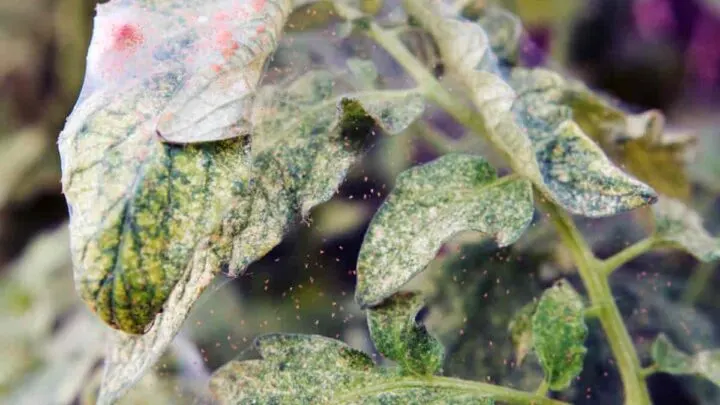
You would think red-colored bugs like spider mites would be easy to spot with the naked eye, but spider mites are better at hiding than that.
Spider mites are tiny and hide beneath the leaves so that you might overlook them at first glance at your plants.
Spider mites are indeed spiders, though small, so you’ll see cobwebs beginning to form on your tomato plants. These pests target the leaves of your tomato plant, so you’ll see them quickly become covered in these fine sheets of web.
Spider mites target and destroy your leaves, but you might be shocked to hear that water is enough to get spider mites off your tomato plants. Just like regular spiders, they’re easy to be knocked off!
Nematodes

Although you might think a nematode is a type of frog, nematodes, when it comes to the garden, best can ravage your tomato plants. A nematode is a parasite.
There is one particular type of nematode called the tomato root-knot nematode, so you know that this is something that strikes tomato plants in particular.
These nematodes target the root of your tomato plants, so you might not even be able to see the devastation happening before it is too late for your tomato plants.
Unfortunately, there aren’t many easy solutions for tomato root-knot nematodes.
First, you’ll need to dig up any affected plants. You’ll have to see how bad the infestation is in your garden.
Next, you’ll have to see if it is possible to rotate the crops around your garden. This won’t solve the problem, so you might notice that the infestation can easily come back to your garden.
Whiteflies
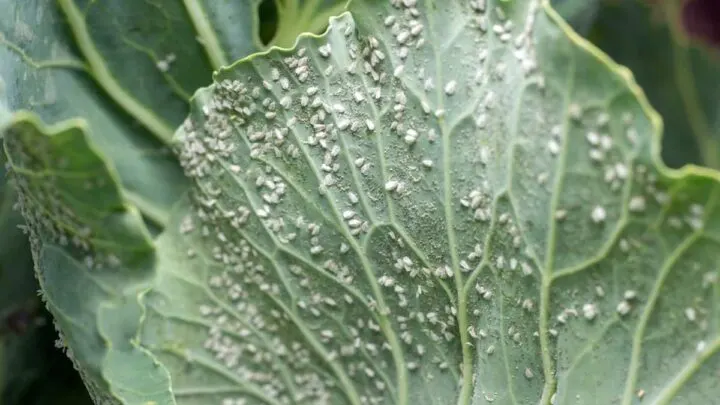
Whiteflies on tomato plants are almost impossible to see on your tomato plants, but that doesn’t mean that they can’t cause severe damage. Looking at the pictures, I sure thought they were just specks of dust on the tops and bottoms of the tomato leaves!
No matter how tiny, whiteflies can devastate tomato plants by sucking out the nutrients your plants need to grow. Your plants will quickly begin to die, and the leaves will begin to fall.
Since whiteflies are tiny, they’re easy to wash away with a spray from your hose, as long as they are caught before your tomato plants begin to suffer.
Make sure to get the top and bottoms of the leaves when spraying your plants down – the baby whiteflies live in hiding!
Stalk Borers
As its name suggests, stalk borers bore inside the stems of plants.
Here’s an interesting tidbit: stalk borers are usually found in ragweed, but they can also be found in tomatoes or even corn.
Stalk borers are purple caterpillars (did that shock you as much as me?), but it’ll be challenging to find them because they’re hiding inside your plant and destroying it from the inside out.
If you think your tomato plants might have stalk borers, you’ll have to become a tomato plant surgeon!
You can slice open the stalk of your tomato plants and remove the stalk borer by hand. However, this can be difficult, so you will need to be careful not to destroy your tomato plants while trying to help.
Hornworms
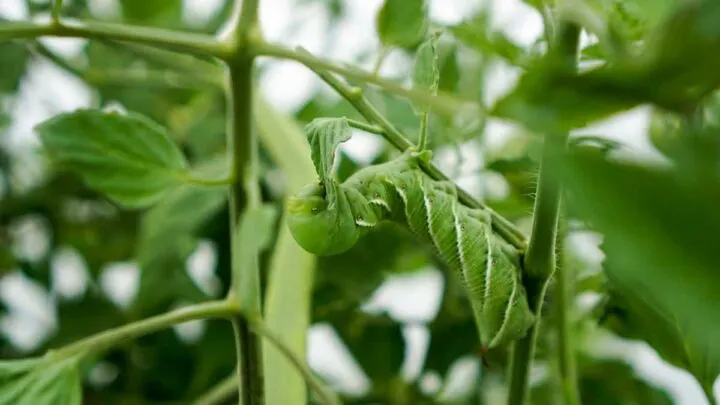
I hate to burst your bubble, but hornworms aren’t as cool as they may sound. Hornworms are green caterpillars that are bright green with horn-like spikes on their bodies.
Though scary-sounding, hornworms are a relatively common occurrence on tomato plants. If you’ve grown tomato plants before, you might not be surprised to see this 5-inch, fat caterpillars on this list.
You’ll know that you have hornworms when you see that your tomato plant has its leaves munched away.
Hornworms are easy to mitigate by hand-picking or using an insecticide if you’d rather not get down and dirty.
Flea Beetles
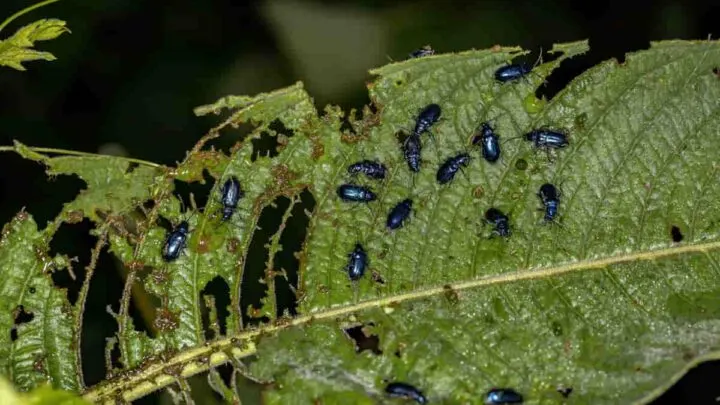
Flea beetles have long back legs that let them hop around like fleas. Sounds like a nightmare, right?
Despite being nightmare fuel, flea beetles are relatively common on tomato plants. You increase your chances of getting flea beetles if you plant tomatoes in the same place every year.
Rotating your crops yearly is the best way to prevent and combat flea beetles. In other words, don’t plant your tomato plants in the same place every year. If you plant tomatoes in the south part of your garden one year, then plant them in the west part of your garden the next year.
Leaf Hoppers
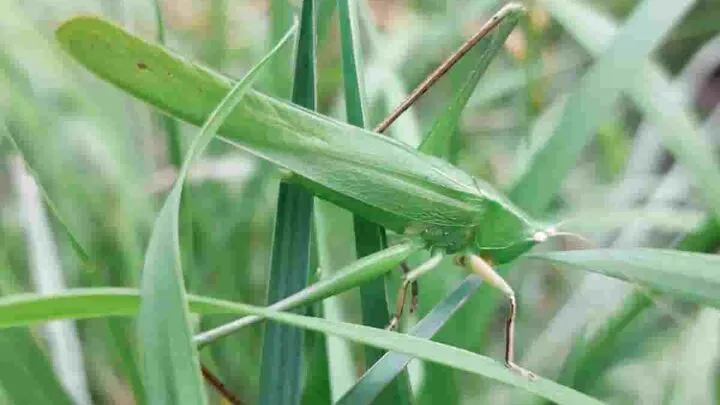
Leaf hoppers don’t live long, but they are a different type of pest that spreads disease rather than ruining the look of your tomato plants.
Most scientists agree that leaf hoppers only live about a month, but that doesn’t mean they can’t seriously damage your tomato crops.
Leaf hoppers cause one disease that is called Tomato Big Bud. It’s a funny name for a disease, but it means something. Leaf hoppers spread a disease that causes buds on your tomato plant to swell.
Big buds sound great for big tomatoes, but that isn’t happening here. It will lead to smaller, oddly shaped fruit.
Thankfully, not everyone growing tomatoes has to worry about Tomato Big Bud because there must be a massive amount of leaf hoppers for the disease to spread across tomato crops.
Leafminers
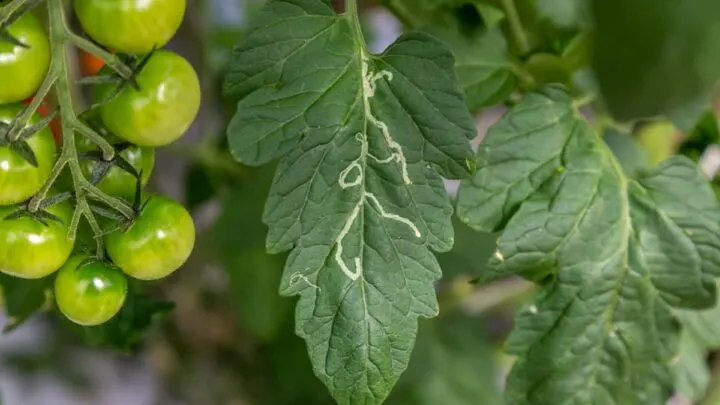
Leafminers are an interesting tomato pest because you need to worry more about the larvae than adult leafminers.
Leafminers are aptly named because the larvae will be laid and eat through the inside of your tomato leaves. Adult leafminers will also much on your tomato leaves, but the damage will not be as severe as the larvae.
You’ll need an insect spray to eliminate leafminers, which can be frustrating if you don’t like to use pesticides in your garden. With leafminers’ damage, it may be an easy choice to use pesticides to manage your best problem.
Blister Beetles
Blister beetles arrive in swarms – and quickly – and can damage your tomato plants at record speeds.
Blister beetles will target your tomato leaves and chew holes in your leaves.
One of the best ways to get rid of blister beetles is through the wildlife around your garden. Birds will pluck blister beetles off your tomato plants and eat them without you having to do anything.
It can feel taboo to say, but you should encourage birds to come near your garden with a bird feeder if you notice that you have blister beetles on your tomato plants.
Wireworms
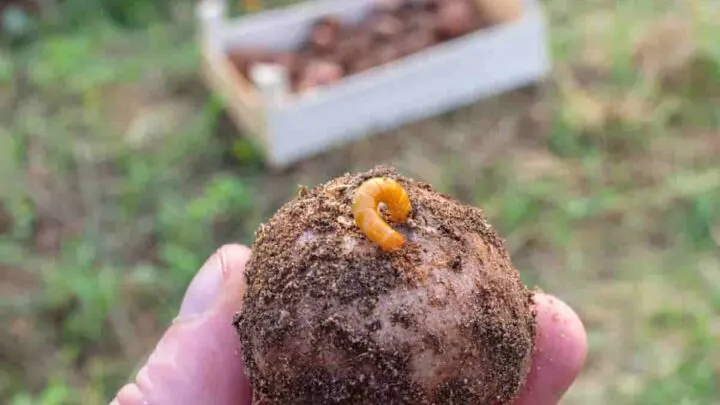
Wireworms attack plants before they have a chance even to grow.
Wireworms will eat your tomato seeds if you plant from seeds, so you won’t see your tomato plants grow. They’ll also attack seedlings if you choose to transplant your tomato plants; they’ll bore their way through the stems of your seedling.
Prevention is the name of the game here. Don’t plant your tomato plants in soil infested with wireworms. If you’re just a casual gardener, wireworms won’t be a huge problem for you or something you will need to worry about.
Tomato fruitworms
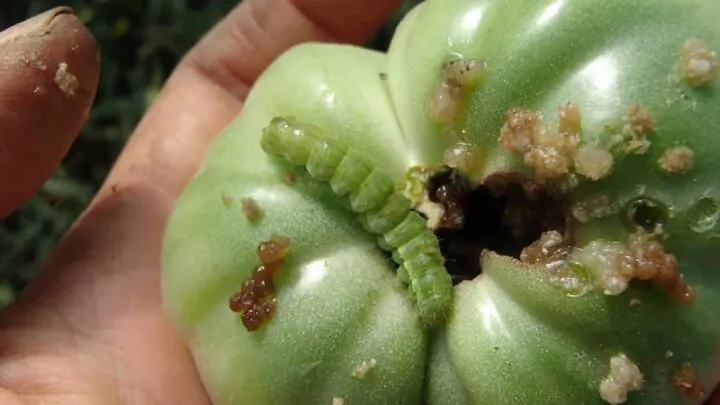
These pests are aptly named because they target tomatoes and can quickly have devastating effects on your plant.
One single tomato fruitworm can eat three or four tomatoes, and that’s before they’re even fully grown!
Since fruitworms can destroy your plants, mitigation is the best choice. You don’t want to deal with fruitworms because they will surely ruin your entire harvest!
Surprisingly, one of the best ways to avoid getting fruitworms is by not planting your tomato crops with corn. Corn is one of the most common hosts for fruitworms, so you don’t want this dangerous pest spreading across your garden.
Slugs And Snails
Let’s end the list with something common but surprisingly harmful to tomato plants: slugs and snails.
You might not think slugs or snails can harm your tomato plants, but they certainly can. They can even eat and destroy the tomatoes as they grow.
Unlike some of the other pests on this list, you have a few mitigation methods that you can try for slugs and snails:
- Sprinkle coffee grounds around your tomato plants
- Put gravel or mulch on the ground around your plants
- Pick away slugs and snails as you see them

Hi there, my name is Allie and welcome to my blog; GareningWithAllie!
Much of what you see written here is just our personal experiences with gardening. Along with the content I write here, there is also a unique collection of gardening topics covered by some of our close friends. I hope you find everything you read here to be helpful, informative, and something that can make your gardening journey the most lovely experience ever! With that said, Happy Gardening!
